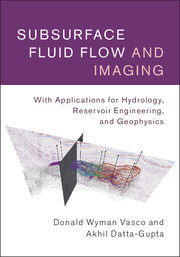 Subsurface Fluid Flow and Imaging
Subsurface Fluid Flow and Imaging Book contents
- Frontmatter
- Contents
- Preface
- Acknowledgments
- 1 The propagation of a disturbance in relation to imaging
- 2 Principles and equations governing fluid flow and deformation
- 3 Trajectory-based modeling
- 4 Equations in diffusion form
- 5 Equations governing advection and transport
- 6 Immiscible fluid flow
- 7 Coupled deformation and fluid flow
- 8 Appendix: a guide to the accompanying software
- References
- Index
- Colour plate section between pages 150 and 151
6 - Immiscible fluid flow
Published online by Cambridge University Press: 05 July 2016
- Frontmatter
- Contents
- Preface
- Acknowledgments
- 1 The propagation of a disturbance in relation to imaging
- 2 Principles and equations governing fluid flow and deformation
- 3 Trajectory-based modeling
- 4 Equations in diffusion form
- 5 Equations governing advection and transport
- 6 Immiscible fluid flow
- 7 Coupled deformation and fluid flow
- 8 Appendix: a guide to the accompanying software
- References
- Index
- Colour plate section between pages 150 and 151
Summary
Introduction
In the Chapter 5 we considered the case in which transported material did not influence the fluid flow. Now we consider the situation in which at least two distinct fluids are present in the porous medium and the presence or absence of one of the fluids will have a significant impact on the flow of the other. In Chapter 2 we discussed the governing equations for the flow of such immiscible fluids, so we will limit our remarks to the key features of such flow. One restriction maintained in this chapter is that the mass transfer between fluid phases is negligible. Such a restriction is not necessary for the adoption of trajectory-based methods, but simply serves to limit the complexity of our treatment.
Governing equations for two-phase flow
A classic example of the type of immiscible fluid flow that we have in mind is the movement of oil and water within a porous material. In fact, this example illustrates some of the most important characteristics of multiphase fluid flow within a solid containing connected pore space. For example, it is often the case that the molecules of one fluid will have an affinity for the molecules of the solid matrix. This fluid tends to adhere to the solid surface of the pores, or to wet the solid. We will denote the saturation of this ‘wetting’ phase by Sw. The other fluid, simply referred to as the ‘non-wetting’ phase, has less attraction for the solid and tends to occupy the central regions of the pores. The saturation of the non-wetting phase is denoted by Sn. Since the pore volume of the medium is completely occupied by some combination of the two fluids, the saturations must sum to unity
Sw + Sn= 1.
The differential affinity for the solid has another consequence, leading to surface tension and curvature in the boundary separating the two fluids. The result is greater pressure in the non-wetting fluid relative to the pressure in the wetting fluid. This pressure difference is termed the capillary pressure, pc, and is most frequently assumed to be a unique function of the fluid saturation:
The capillary pressure curve pc(Sw) is an important aspect of multiphase fluid flow and a key constitutive equation. However, the difference in capillary pressure is often much smaller than the average fluid pressure.
- Type
- Chapter
- Information
- Subsurface Fluid Flow and ImagingWith Applications for Hydrology, Reservoir Engineering, and Geophysics, pp. 220 - 284Publisher: Cambridge University PressPrint publication year: 2016


